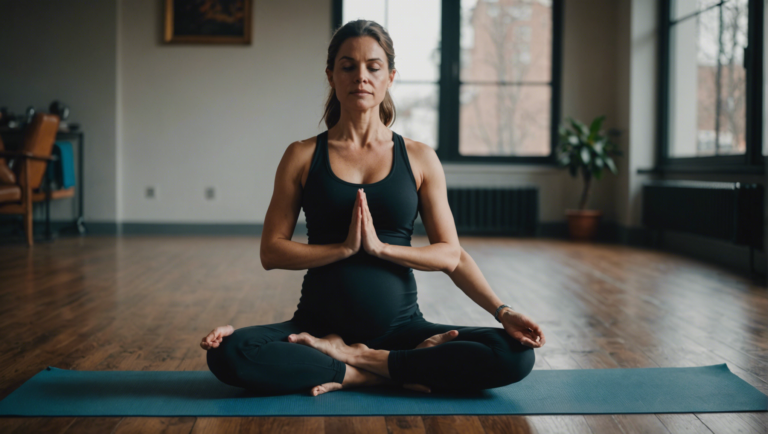Is Yoga Good When Trying To Conceive
The Impact of Yoga on Fertility: A Closer Look
The Link Between Yoga and Enhancing Fertility
The journey towards conception is often a complex blend of physical, emotional, and sometimes medical challenges. Amidst the myriad of advice given to couples trying to conceive, yoga emerges as a beacon of hope. The ancient practice, rooted in creating harmony between the body and mind, offers more than just physical benefits; it potentially paves a smoother path to fertility.
Understanding Yoga’s Holistic Benefits
Yoga is much more than stretching or achieving impressive poses; it is a holistic practice that promotes overall well-being, which is crucial when trying to conceive. The sequences and postures (asanas) in yoga are designed to enhance muscle tone, flexibility, and blood circulation, all of which contribute positively to reproductive health. However, the benefits are not merely physical.
Stress is a known inhibitor of fertility, impacting hormone levels and ovulation patterns. Yoga, through its meditative component and focus on deep, mindful breathing (pranayama), offers an effective stress-relief method. Regular yoga practice helps in cultivating a state of mental and emotional serenity, reducing anxiety, and fostering a positive mindset, which can be instrumental for couples facing the challenges of conception.
Yoga’s Direct Influence on Reproductive Health
Certain yoga poses are believed to specifically support reproductive health by increasing blood flow to the pelvis, balancing hormone levels, and relieving tension in the lower back and hip areas. Poses like the Supported Bridge Pose, Butterfly Pose, and Legs-Up-The-Wall Pose are often recommended for their gentle, restorative effects on the pelvic region.
Moreover, yoga’s emphasis on mindfulness and connection to one’s body encourages a heightened sense of self-awareness. This awareness can lead to better recognition of the body’s fertility signals, making it easier for women to track their cycles and identify their most fertile periods.
Science and Research on Yoga’s Impact on Fertility
While empirical research on yoga specifically for fertility enhancement is still in its nascent stages, several studies have highlighted the positive effects of yoga on stress reduction and overall well-being, factors intimately linked with fertility. A study published in the "Journal of Obstetrics and Gynaecology Research" observed that women who participated in fertility-specific yoga programs reported significant reductions in stress and anxiety levels.
Another aspect under scientific scrutiny is the potential for yoga to improve outcomes for women undergoing fertility treatments. Preliminary research suggests that yoga may increase the success rates of treatments like in vitro fertilization (IVF), with participants noting not just improved physical health, but also a better emotional and mental state through their treatment cycles.
Implementing a Yoga Routine
For those new to yoga, starting with gentle, beginner-friendly classes is crucial. It’s essential to listen to your body and avoid overexertion, particularly with poses that put pressure on the stomach or lower abdomen. Many yoga studios and wellness centers offer classes specifically designed for fertility, focusing on poses and practices known to support reproductive health.
Additionally, incorporating mindfulness and meditation practices alongside the physical aspects of yoga can amplify its stress-relieving benefits. A holistic approach, combining physical postures with breathing exercises and meditation, ensures a comprehensive nurturing of the body and mind.
Final Thoughts
While yoga alone cannot guarantee conception, its myriad benefits make it a worthwhile consideration for couples on their fertility journey. The practice offers a form of gentle, supportive therapy that nurtures the body, soothes the mind, and enriches the spirit. In the sometimes turbulent journey toward creating new life, yoga stands out as a sanctuary of calm and a source of strength, offering hope and healing in equal measure.
Complementary Yoga Poses and Practices for Enhancing Conception
Navigating the journey to conception can be both an exciting and challenging period for many. The intricate balance of physical health, emotional wellbeing, and the often overlooked aspect of stress management plays a critical role in enhancing fertility. Within this sphere of holistic health, yoga emerges not only as a physical exercise but as a deeply integrated practice beneficial in aligning the body, mind, and spirit towards the goal of conception.
Embracing Yoga for Fertility Enhancement
Yoga, with its roots deeply embedded in the promotion of holistic health, offers a compelling approach to supporting couples on their conception journey. The practice is renowned for its ability to reduce stress, improve circulation, and balance hormone levels, all of which are crucial factors when trying to conceive. By engaging in specific yoga poses and practices, prospective parents can create an optimal environment for conception.
The Science Behind Yoga and Fertility
The correlation between yoga and improved fertility is more than anecdotal. Research has shown that stress significantly impacts fertility, affecting hormone levels and ovulation cycles. Yoga, known for its powerful stress-reducing capabilities, can directly influence the body’s stress response, promoting a more conducive state for conception. Moreover, the improvement in circulation and the balancing of the endocrine system through yoga practices further supports reproductive health.
Recommended Yoga Poses for Conception
Certain yoga poses are believed to be particularly beneficial for those trying to conceive, focusing on improving pelvic blood flow, balancing hormone levels, and reducing stress.
-
Supta Baddha Konasana (Reclining Bound Angle Pose): This restorative pose helps to open the hips and increase circulation to the pelvic region, facilitating a nurturing environment for conception.
-
Balasana (Child’s Pose): A soothing pose that not only stretches the lower back but also promotes relaxation and stress relief, aiding in the reduction of the physical and emotional barriers to conception.
-
Setu Bandhasana (Bridge Pose): Known for its ability to stimulate the abdominal organs, this pose can improve circulation to the reproductive organs and balance the thyroid gland, a key hormone regulator.
-
Viparita Karani (Legs Up the Wall Pose): Often recommended for its potential to enhance fertility, this gentle inversion increases blood flow to the pelvic area, supporting healthier reproductive functioning.
Integrating Pranayama and Meditation into Fertility Yoga Practices
Beyond the physical poses, the inclusion of pranayama (breath control) and meditation in a yoga practice can profoundly impact one’s mental and emotional state, further enhancing fertility. Techniques such as deep abdominal breathing and guided meditations focused on fertility can help to alleviate stress and create a positive and peaceful mental environment conducive to conception.
-
Deep Abdominal Breathing: Helps to activate the parasympathetic nervous system, reducing stress levels and creating balance within the body’s systems.
-
Fertility-Focused Meditation: These guided meditations can help in releasing emotional blockages related to fertility, reinforcing a positive mindset and reducing stress.
The Holistic Impact of Yoga on the Conception Journey
Yoga offers more than just physical benefits; it is a holistic practice that nurtures the body, soothes the mind, and uplifts the spirit. In the context of conception, it provides a sanctuary for prospective parents to connect deeply with themselves and each other, fostering an environment of love, peace, and readiness for the next chapter of their lives.
By incorporating specific yoga poses, pranayama, and meditation practices into their daily routine, individuals and couples can significantly enhance their conception journey. As always, it is recommended to consult with a healthcare provider before beginning any new exercise regimen, especially when considering pregnancy.
Yoga, in its essence, is a journey of the self, through the self, to the self. In the context of trying to conceive, it becomes a beautiful bridge to not only improving fertility but also preparing the body and soul for the sacred journey of parenthood.
Conclusion
Embarking on the journey toward conception, many couples find themselves navigating through a plethora of advice, treatments, and strategies aimed at enhancing fertility. Within this expansive realm of reproductive health, yoga emerges not as a mere physical activity but as a holistic approach intertwining body, mind, and emotional well-being. The exploration into the impact of yoga on fertility and the introduction of complementary yoga poses specifically designed to boost conception has illuminated a promising path for those yearning to conceive.
The intricate relationship between yoga and fertility operates on multiple levels, offering a nuanced understanding of how this ancient practice can act as a catalyst for conception. First and foremost, yoga fosters an environment of relaxation and stress reduction. In the high-stakes quest for pregnancy, stress levels can skyrocket, potentially impeding conception. Cortisol, the so-called "stress hormone," can significantly affect hormonal balance, disrupting menstrual cycles and ovulation. Yoga, through its stress-alleviating properties, can mitigate these effects, fostering a more conducive environment for conception. Through guided breathing techniques (pranayama) and meditation, yoga practitioners report a greater sense of calm and mastery over stress, directly impacting their reproductive health positively.
Moreover, specific yoga poses target the reproductive system by enhancing blood flow and balancing the endocrine system. Poses such as Setu Bandhasana (Bridge Pose), Bhramari Pranayama (Bee Breath), and Balasana (Child’s Pose) are celebrated for their potential to open up the pelvic region, ensuring a rich supply of oxygenated blood to the reproductive organs. This increased circulation not only nourishes the organs but also aids in detoxifying and clearing any blockages that might impede fertility. Furthermore, the gentle stretching and strengthening involved in yoga can help alleviate conditions such as Polycystic Ovary Syndrome (PCOS) and endometriosis, which are known barriers to conception.
Yoga doesn’t just target the physical barriers to pregnancy; it also addresses the emotional and mental challenges that accompany fertility struggles. The journey toward conception can be emotionally taxing, fraught with highs and lows that can wear down even the most resilient individuals. Yoga’s emphasis on mindfulness and living in the present moment can be a salve to the emotional turmoil, providing a space for acceptance, healing, and sometimes even a renewed sense of hope and positivity. The mindfulness practiced on the mat cultivates a mindset that values patience and perseverance, qualities that are invaluable on the road to conception.
Additionally, the community aspect of yoga can offer a supportive network for those undergoing fertility challenges. Being part of a group that shares similar experiences and struggles can reduce feelings of isolation and provide emotional support and encouragement. Whether it’s through in-person classes or virtual gatherings, the yoga community can play a significant role in supporting individuals and couples during their fertility journey.
As we bridge the ancient wisdom of yoga with the contemporary quest for fertility, it becomes evident that yoga offers more than just physical benefits; it provides a holistic approach to conceiving, touching on the physical, emotional, and mental facets of reproductive health. Its adaptability and inclusiveness make yoga an accessible and valuable practice for those at any stage of their fertility journey. The encouraging findings on the impact of yoga on fertility and the specific poses recommended for enhancing conception offer a beacon of hope for many. This holistic approach not only aids in creating the optimal physical conditions for pregnancy but also crafts a sanctuary of peace and resilience amidst the emotional whirlwind of trying to conceive. As yoga continues to intertwine with the science of fertility, it paves a path of well-being, hope, and vitality for aspiring parents.


